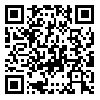Volume 24, Issue 2 (8-2025)
TB 2025, 24(2): 59-74 |
Back to browse issues page
Ethics code: IR.SSU.SPH.REC.1403.224
Download citation:
BibTeX | RIS | EndNote | Medlars | ProCite | Reference Manager | RefWorks
Send citation to:



BibTeX | RIS | EndNote | Medlars | ProCite | Reference Manager | RefWorks
Send citation to:
Mousavi S M, Khaledi E, Bahariniya S, babaie zarch F, Bustani F. The Relationship between Health Literacy and Patient Satisfaction among Cardiac Patients with Staff: A Case Study at the Educational Hospital in Yazd. TB 2025; 24 (2) :59-74
URL: http://tbj.ssu.ac.ir/article-1-3742-en.html
URL: http://tbj.ssu.ac.ir/article-1-3742-en.html
Shahid Sadoughi University of Medical Sciences , elhamkhaledi76@gmail.com
Abstract: (81 Views)
Introduction: Health literacy includes the ability of an individual to understand and evaluate health information in order to make the right decisions about improving their quality of life. The present study aimed to investigate the relationship between health literacy and satisfaction of heart patients with staff.
Methods: The present study was a descriptive-correlational study that was conducted cross-sectionally in 1403 on 131 cardiac patients at Afshar Hospital in Yazd. Data were collected using standard Iranian health literacy questionnaires (HELIA) and patient satisfaction questionnaires and analyzed using SPSS version 27 software.
Results: The mean patient satisfaction score was 79/96 ± 17/2 and the mean health literacy score was 61/18 ± 20/96, indicating insufficient health literacy. Among the health literacy dimensions, the highest mean score was related to the decision-making and use of health information dimension and the lowest score was related to the reading skills dimension. Among the patient satisfaction dimensions, the highest mean score was related to the medical staff dimension and the lowest score was related to the nursing staff dimension. Also, no significant relationship was observed between health literacy and patient satisfaction.
Conclusion: Although the overall relationship between health literacy and patient satisfaction was not significant, their different dimensions independently had coherent structures and were related to each other; in such a way that improving one dimension can lead to improving other dimensions. It is also recommended to hold workshops, produce simple and understandable educational content, and strengthen effective communication with patients in order to improve patient health literacy.
Methods: The present study was a descriptive-correlational study that was conducted cross-sectionally in 1403 on 131 cardiac patients at Afshar Hospital in Yazd. Data were collected using standard Iranian health literacy questionnaires (HELIA) and patient satisfaction questionnaires and analyzed using SPSS version 27 software.
Results: The mean patient satisfaction score was 79/96 ± 17/2 and the mean health literacy score was 61/18 ± 20/96, indicating insufficient health literacy. Among the health literacy dimensions, the highest mean score was related to the decision-making and use of health information dimension and the lowest score was related to the reading skills dimension. Among the patient satisfaction dimensions, the highest mean score was related to the medical staff dimension and the lowest score was related to the nursing staff dimension. Also, no significant relationship was observed between health literacy and patient satisfaction.
Conclusion: Although the overall relationship between health literacy and patient satisfaction was not significant, their different dimensions independently had coherent structures and were related to each other; in such a way that improving one dimension can lead to improving other dimensions. It is also recommended to hold workshops, produce simple and understandable educational content, and strengthen effective communication with patients in order to improve patient health literacy.
Type of Study: Research |
Subject:
General
Received: 2025/03/17 | Accepted: 2025/06/7 | Published: 2025/09/11
Received: 2025/03/17 | Accepted: 2025/06/7 | Published: 2025/09/11
Send email to the article author
| Rights and permissions | |
 |
This work is licensed under a Creative Commons Attribution-NonCommercial 4.0 International License. |



